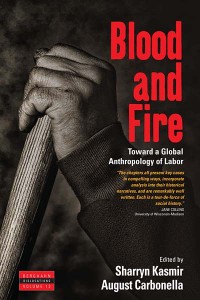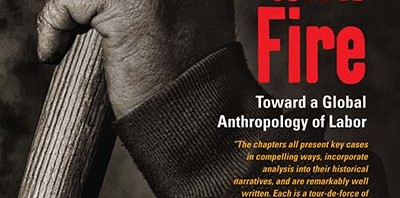The informal sector in the economy has been rising recently from a concept that designated marginal forms of labor occurring in Third World cities – that grew in the 1970s without formal growth and created a from Western perspective atypical ‘Third World unemployment’ (cf. Hart 2009) – to one designating flexibilized, temporary or quasi-self-employed work in the neoliberal era in cities around the world. The volume at hand provides six ethnographies from cities in Spain, India, Poland, Columbia, and US that use dispossession as analytical lens to conceptually frame these processes, which they call the multiplication of labor (informal, criminalized, military, child labor etc.) emerging through programs of structural adjustment, penalization, military and paramilitary violence in both North and South (East and West). Looking at the multiple processes by which once negotiated protections are successively removed and collective resources are privatized – not as separate processes dispersed in time and space, but actually intertwining – the authors effectively question the North-South divide so prominent in labor analysis. However, as I will argue below, through the focus on a certain form of dispossession of workers, which worldwide reorganizes the allegedly well-known divisions between forced (slave) and skilled labor, male (productive) and female (reproductive) work, between dependent wageless poor lumpen and those who can offer their labor as free and equal subjects on the market in exchange for monetary wage, they fail to reformulate the relation between wage and politics that assumed a particular form under Fordist production, but has undergone changes since then.
 A great strength of the book is that the case studies do not only expand in space but also in time and provide detailed case studies that are orchestrated around the complex processes that lead to what Harvey designated as the actual consequence of neoliberalism: the restoration of capitalist class power (cf. Harvey 2005). This becomes very explicit in the chapters by Kasmir on the US-based Saturn plant funded in the mid-1980s and by Narotzky on shipyards in Spain, who both trace the way a strong culture of unionism is disarmed. In Spain it is through the specialization of workers in macro-economic planning rationality (economic nationalism) and in the case of US it is through the introduction of micro-economic competitive localism. The idea behind both processes is the same: dismantling particular class interests vis-à-vis an abstract enemy of flexible capital.
A great strength of the book is that the case studies do not only expand in space but also in time and provide detailed case studies that are orchestrated around the complex processes that lead to what Harvey designated as the actual consequence of neoliberalism: the restoration of capitalist class power (cf. Harvey 2005). This becomes very explicit in the chapters by Kasmir on the US-based Saturn plant funded in the mid-1980s and by Narotzky on shipyards in Spain, who both trace the way a strong culture of unionism is disarmed. In Spain it is through the specialization of workers in macro-economic planning rationality (economic nationalism) and in the case of US it is through the introduction of micro-economic competitive localism. The idea behind both processes is the same: dismantling particular class interests vis-à-vis an abstract enemy of flexible capital.
In the case of US, Kasmir describes how the Clinton government 1992 officially introduced a model of labor-management cooperation in labor law as means to increase work-place productivity. Workers were systematically sensitized for financial matters via organizing them in small working groups that assumed responsibility for increasing the efficiency in their own team. This legislation amendment and its application in the model plant Saturn in Tennessee was promoted in huge advertisement campaigns that intended to make the public believe that labor-management cooperation would be more efficient on the long run than independent unions (advertisements, for example, tried to play with the slogan ‘being in bed with management’ and give it a positive connotation). The language of class antagonism was slowly erased from the company. This went along with an aggressive localism being articulated by the leader of Saturn union, Local 1853, saying: ‘if unions have a future it’s at the local level’ where they can help companies ‘explore opportunities to compete’” (Kasmir 306). This claim very much corresponds to the experiences of many of the Saturn workers, who came to the rather rural Tennesse from different deindustrializing cities like Detroit, Flint, Michigan etc. and were sensitized to the disposability of the plants where they had worked before. In Kasmir the making of difference is basically a ‘destructive’ process of disorganization that undermines solidarity with other workers in other locations in favor of an aggressive localism.
Narotzky in her chapter on Ferrol, which was the location of shipyards labeled as key industries until their radical downsizing in the mid-1980s, analyses the role of transmission of memories of defeat in the definition and framing of conflicts. In her chapter the making of difference is not rejected as an inherently conservative force. Rather Narotzky uses militant particularism (cf. Williams 1977) to signify a “form of struggle which tries to capture the reality of different scales operating simultaneously. It addresses the challenge to both acknowledge the ‘logic’ of connections within the system, both time and space connections, without losing their particular expression and the experience that drives people to think in terms of a community of interest” (Narotzky 261). Reading the ‘making of difference’ as militant particularism helps to understand dynamics at the local level like memory that have the potential to disentangle scales and recreate tensions, and thus ultimately challenge the narrative of ‘what is good for capital is good for all’ (Kasmir/Carbonella). As Narotzky shows, militant particularism could grow on different grounds. One is highly local, such as protests against construction of a natural gas plant that brought together different interests groups arguing that it would endanger shellfish gathering, devalue adjoining property or be a case of political corruption. Because of the fragility of the consent among differently motivated social groups that entered the local protest, the leaders of the protest are hesitant to align for example with transnational environmental movements. Another potential ground for the development of militant particularism is in Narotzky’s reading economic nationalism. Originally, this concept was introduced in Spain by the radical left, before it allegedly became another ground on which to legitimate the cooptation of capital and workers’ interests. However, in Ferol economic nationalism eventually became the grounds on which the ‘sons of the shipyard’, once hired for an international textile company, managed to deploy their wisdom about political economic analysis inherited from their fathers to wage a struggle.
Narotzky’s differentiated notion of militant particularism emerges from her historical account that shows how the cooptation of labor and capital interests builds on the formalization of unions that is typical of the Keynesian state and became disruptive for labor solidarity only in the increased competition for investments and production locations from the 1980s on. However, she also shows how the macro-economic planning rationality was introduced already during the gradual liberalization of Francoist Spain under adjustment programs of the International Bank for Development and Reconstruction from the 1960s on. And corporatism, the idea that the fate of the workers is tied to the fate of the employers, was already inherent in the economic nationalism that went along with the politics of import substitution from 1957 on.
Contrary to many current studies of neoliberalism most of the authors of the volume at hand do not one-sidedly bemoan a Keynesian, welfarist past that is alluded to by means of contrast to the alleged rupture of neoliberal restructuring, but show actual path dependencies. This approach becomes very clear in Carbonella’s chapter on unions in the paper and forest industries in northeast US, where it was the ethnic cleavages created during strikes in 1921, which the author describes as typical for US Fordism, that effectively undermined strikes in 1987. Moreover, this approach turns out to be crucial in reconstructing the way dispossession of workers in post-socialist Poland was, as Kalb shows in his chapter on the defeat of Solidarnosc union, in the first place facilitated through the installment of private property (company shares were given to the workers) and its subsequent reappropriation by the liberal state through bankruptcy, loans and the impositions of structural adjustment.
 From these short summaries it becomes already apparent that the labor the authors look at is classical Fordist wage-labor, secure and unionized as it is in strategic industries (in Spain the shipyard, in US the story only begins with neoliberal reforms and the setup of a model plant which is central in the dispossession/disenfranchisement of formerly strongly unionized autoworkers, in the chapter by Gill on Columbia the foreign enclave oil industry, in Mumbai the textile industry etc.). Although sensible of path dependencies, the chapters tell the story of the dismantling of Fordist key industries and the defeat and fragmentation of working class solidarity. The subject of history and revolutionary politics in this volume is, quite orthodox Marxist, the urban male manufacturing worker. From this vantage point the chapters reify the fetishism of formal wage contract (cf. Denning 2010) and thus neglect forms of labor that appear outside of this contract and forms of politics that draw on other relations than wage and appear in other spaces than the factory. Whereas the focus of the book seems to lie on showing global continuities of what neoliberal restructuring does to (I would argue wage-) labor, this goes at the expense of targeting non-wage forms of labor. For example in the case of Gill’s chapter on Columbia, peasants expelled from the countryside are mentioned only as those inhabiting the urban fringes in a state of un- or underemployment and they enter the historical process only when oil workers’ union mobilized them in civic strikes that demanded improved public services in the mid-1970s. A more differentiated perspective is deployed when the current un- and underemployed are discussed: such as migrant workers who are highly exploitable through modes of subcontracting. However, this group again fits the grand narrative of this book: that informality gained center stage under neoliberalism (cf. Harvey 1989).
From these short summaries it becomes already apparent that the labor the authors look at is classical Fordist wage-labor, secure and unionized as it is in strategic industries (in Spain the shipyard, in US the story only begins with neoliberal reforms and the setup of a model plant which is central in the dispossession/disenfranchisement of formerly strongly unionized autoworkers, in the chapter by Gill on Columbia the foreign enclave oil industry, in Mumbai the textile industry etc.). Although sensible of path dependencies, the chapters tell the story of the dismantling of Fordist key industries and the defeat and fragmentation of working class solidarity. The subject of history and revolutionary politics in this volume is, quite orthodox Marxist, the urban male manufacturing worker. From this vantage point the chapters reify the fetishism of formal wage contract (cf. Denning 2010) and thus neglect forms of labor that appear outside of this contract and forms of politics that draw on other relations than wage and appear in other spaces than the factory. Whereas the focus of the book seems to lie on showing global continuities of what neoliberal restructuring does to (I would argue wage-) labor, this goes at the expense of targeting non-wage forms of labor. For example in the case of Gill’s chapter on Columbia, peasants expelled from the countryside are mentioned only as those inhabiting the urban fringes in a state of un- or underemployment and they enter the historical process only when oil workers’ union mobilized them in civic strikes that demanded improved public services in the mid-1970s. A more differentiated perspective is deployed when the current un- and underemployed are discussed: such as migrant workers who are highly exploitable through modes of subcontracting. However, this group again fits the grand narrative of this book: that informality gained center stage under neoliberalism (cf. Harvey 1989).
Carbonella/ Kasmir in their introduction criticize that available studies on those “who are permanently constituted as the ‘outside’ of capitalism” (15) – coming mostly from the field of citizenship studies – tend to ignore labor relations. It is a welcome shift in perspective to see these populations through the lens of the actual multiplication of proletariat and to illuminate developments through which informality increasingly constitutes the center of capitalism. However, contrary to the author’s claim to theoretically decentralize the wage relation, the chapters rather show how wage relation is decentered through historical process, i.e. the increasing replacement of key industries through flexibilized, insecure forms of labor, which do not “constitute the ‘outside’ of capitalism, but increasingly, its center” (Carbonella/Kasmir 16). In that the authors circumvent urgent theoretical questions that go along with this shift and do not develop a new vocabulary with which we could grasp new politics that might develop. Instead, many of the authors quite unproblematically transfer concepts like ‘militant particularism’, which builds on “quite stable working-class communities often united by a dominant industry and rooted very strongly in particular localities” (Featherstone 1998:19), from the Fordist context where it emerged to the current era.
The informal is equated with the defeat and disorganization and the informal sector itself often black-boxed. For example the chapter by Whitehead, which gives an otherwise important contribution to the literature on precarious housing so prominent in citizenship studies and urban anthropology (which often lacks a perspective on labor), the defeated mill workers in Mumbai literally disappear from the gathering ground of the factories in an ‘underworld’ of ‘criminal organizations’. Their solidarity is dispersed in the jumble of Mumbai’s streets, where the men informally work as cab drivers and their wives contribute to the family income as domestic workers, but are singularized in households, which in Whitehead’s account forestalls the possibility of joint action.
In that a more long-term perspective on the politics behind the way wage and wagelessness are differentiated mostly disappears, although, interestingly, Carbonella discusses the classification of workers as ‘unskilled’ as a technique in the defeat of the 1921 strikes. For a book on a global anthropology of labor it would have been also important to look at how wageless population is progressively entrepreneurialized through micro-credits or employment initiatives where they are encouraged to think about themselves as investment objects. This process puts into question the clear division between the classes with and without means of production (and the consequences this has for processes of dispossession taking for example the form of debt relations) (Sanyal 2007). Here one could also mention forms of dispossession (especially in the Global South) that work through what is labelled as formalization (especially in the realm of land rights or schemes that empower those in the informal economy). These processes effectively reverse the causality deployed in the volume reviewed here, which argues that it is informalization which leads to defeat, disorganization and dispossession. I would argue that it is necessary to question this formal/informal divide and be aware of the making of difference and its (de-)politicizing impact on both sides. It is necessary to critically reflect on the notion of politics deployed in this volume as being derived from a particular historical period that normalized employment and the wage contract.
 Eva Schwab studied Sociology and Social and Cultural Anthropology in Münster and Vienna. She is currently Ph.D. student at Central European University in Budapest.
Eva Schwab studied Sociology and Social and Cultural Anthropology in Münster and Vienna. She is currently Ph.D. student at Central European University in Budapest.
References
Denning, Michael (2010): “Wageless Life”. In: New Left Review 66.
Featherstone, David (1998): “Some Versions of Militant Particularism: A Review Article of David Harvey’s Justice Nature and the Geography of Difference. In: Antipode 30(1):19-25.
Hart, Keith (2009): “On the Informal Economy: the political history of an ethnographic concept”. In: Centre Emile Bernheim. http://ideas.repec.org/p/sol/wpaper/09-042.html
Harvey, David (2005): A Brief History of Neoliberalism. Oxford, New York: Oxford University Press.
Harvey, David (1989): The Condition of Postmodernity. Oxford: Basil Blackwell.
Sanyal, Kalyan (2007): Rethinking Capitalist Development: Primitive Accumulation, Governmentality and Post-Colonial Capitalism. New Delhi: Routledge India.
Williams, Raymond (1977): Marxism and Literature. Oxford, New York: Oxford University Press.

